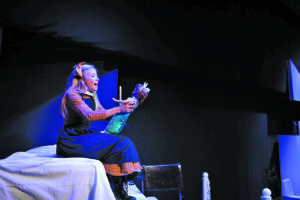
Fall Church’s George Mason High School may not be the biggest in the area, but when it comes to robotics, Mason’s size is no impediment.
From their start in 2004, Mason’s robotics students have consistently won area and district contests in Northern Virginia, Maryland and the Chesapeake region, and last year, for the second consecutive year, qualified for the world championship in St. Louis where they lost a tiebreaker in the quarterfinals.
This year they’re coming back stronger than ever with a determination to match any Olympic athlete’s. The Mason team, named 1418, is ranked in the top one percent of 3,647 teams with 91,000 students nationwide. About 30 students participate in the sport at Mason where all skill levels and talents are invited, and no one sits on the bench.
On a recent afternoon, the energy and enthusiasm team members and their adult mentors exude were quickly palpable to a visitor at an after-school meeting.
The team was finishing up work on its entry for this year’s district competitions, a robot named “Panthera” (Latin for “giraffe”), a slinky, sleek assembly of steel, wires and other materials which can extend about six feet.
“We have a lot of connections to Latin around here,” said Erik Boesen, a junior and programming captain.
Panthera must be built and assembled in six weeks before it is bagged, tagged and placed in a huge plastic bag to be carted to Haymarket for its first competition in March so every team starts on a level playing field, according to John Krotzer, a parent volunteer whose son, Dominik, is a freshman on the team.
Krotzer described the competitive process: Mason is paired with two other teams they’ve never met who work together to beat three opposing teams which one student jokingly called “the enemy.”
Triggered by student laptop commands, Panthera jetted from the station like a race car at NASCAR. It only has a few seconds to complete an assigned task list.
“It’s so exciting, it’s like the Super Bowl, really it is,” Krotzer said twice over the course of the afternoon. “This application is important in life no matter what you do. Anything getting people to work together is very important.”
Belly laughs erupted from team members when asked if they got their tech leanings from parents. As youngsters, Addison Rasmussen and Boesen liked to take computers apart, and Boesen was injured when he disassembled an old analog television. Only Anuragi Thapliya, a freshman who started her robotics training in middle school, identified her mother, a computer programmer, as an inspiration for the program.

Cooper McGuire, team co-captain and senior, chuckled when he said, “My parents definitely are not engineers. They are economists who work for the U.S. government.”
When he was a freshman, he took engineering drawing classes from John Ballou who whetted McGuire’s appetite for robots. Ballou, who retired last year after 36 years, started Mason’s program in 2004 and still spends hours with the robotics students every week.
“This is about making decisions and building something,” Ballou said after another afternoon tinkering with the robot. “It’s about testing it out, seeing what happens, breaking it, changing your mind, rebuilding it. It’s what most of what the real world experiences. In academics, you don’t get that kind of learning experience. This is real trial and error.”
After Ballou’s official departure at Mason, Steven Knight took over the school’s robotic reins and he is “really happy to be part of [this]. It’s about building a community but we also are looking to get more teachers involved.”
Students speak proudly of their association with the international youth organization, FIRST (For Inspiration and Recognition of Science and Technology), founded by Dean Kamen (the inventor of the Segway) who wants to inspire young people to pursue science and technology, all in line with STEAM (science, technology, engineering, arts and math) goals.
It’s the FIRST competition which students target.
Rasmussen said he and his fellow students spend three hours every day after school on the project and from 10 a.m. – 6 p.m., Saturdays and Sundays during “build season.”
But “academics” always come first, said Boesen and McGuire slowly, amidst snickers and under their breaths as if to convince themselves they believe it. They get no class credit for robotics.
The team and mentors are grateful to the City’s school board and Falls Church Education Foundation for their support, but Krotzer writes the majority of funding and services comes from corporations and local businesses like Booz Allen, Leidos, Setty Construction, and the McGuire Group.
He hopes an engineering firm that wants the construction contract for Mason sponsors the FIRST team which would make “a great fit!”
Said Boesen, “Education is the key to the future. We should be investing a lot in these areas.”
He got hooked on robotics at the Farmer’s Market when he was about eight years old. “I actually saw member of the team do a demonstration and I said ‘whoa! This is so cool. When I grow up I want to be just like them!’”
And so he is.










